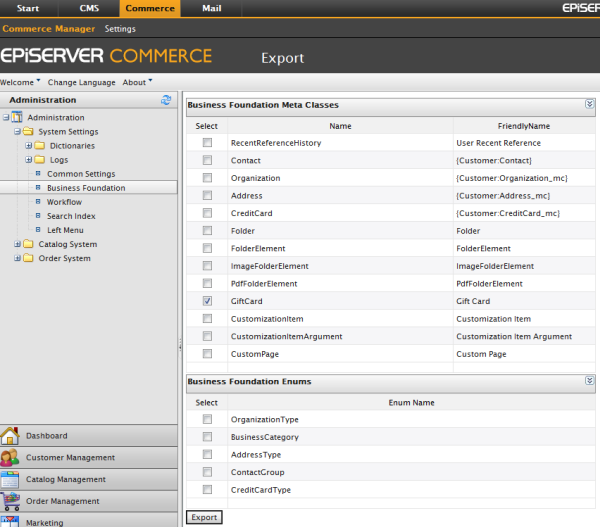A critical vulnerability was discovered in React Server Components (Next.js). Our systems remain protected but we advise to update packages to newest version. Learn More.
Upgrading Episerver Commerce from version 1 R2 SP1 to 1 R2 SP2
| Product version: | Episerver Commerce 1 R2 SP1/1 R2 SP2 |
|---|---|
|
Document last saved: |
Introduction
This document describes the procedure for upgrading EPiServer Commerce from version 1 R2 SP1 to 1 R2 SP2 (for EPiServer CMS 6 R2). NOTE that this procedure only supports upgrade from EPiServer Commerce 1 R2 SP1, meaning that if you have a site based on an earlier version, you must first upgrade it to version R2 SP1.
Prerequisites
Check the following before you start the upgrade:
- The database server must have full text search service enabled.
- After installing EPiServer Commerce R2 SP1, you need to open Commerce Manager from your browser and log in. When logging in to Commerce Manager the first time, the system will do some setup changes and generate new database tables. This step is necessary, otherwise the further upgrade process will fail.
- If your site has Quartz Service installed, make sure to stop the service before upgrading.
- If your site has custom business foundation objects, refer to the section "Exporting and Importing Business Foundation Objects" below.
- If your order system has existing orders before the upgrade, refer to the section "Managing Existing Orders After Upgrading" below.
Exporting and Importing Business Foundation Objects
Before you do the actual upgrade, you need to export any customized business foundation objects. After a successful upgrade, the customized business foundation objects will then be imported back to the upgraded site.
Follow these steps to export and then import customized business objects for your website.
- Before the upgrade, navigate to Commerce Manager/Administration/System Settings/Business Foundation, and select Export to export your custom business objects.

- Select the customized business objects to export. Be sure to only export the custom objects and NOT the system objects!
NOTE If your business objects have relations to other business objects, you must export the related objects as well. When you have done your selection, click Export.

- Return to the list view and delete all of your custom business foundation objects by clicking the Delete button next to the customized objects in the list of business foundation objects.
- After a successful upgrade (see below), import the business foundation objects that you exported in the previous step. To import, select the Import option in the list of business foundation objects.
Upgrading of Site With Sample Templates
This section applies if the sample templates are installed on your EPiServer Commerce website.
If your sample site has Commerce gadgets (gadgets for Orders, Overview, Approval, Abuse Report or CMO settings), you should remove those gadgets before doing the upgrade, because in the 1 R2 SP2 release Commerce specific gadgets have been moved to the EPiServer Commerce core and will be installed from there. For more information about gadget configuration and disabling, refer to this document about OnlineCenter Development.
Upgrading Procedure
Follow these steps to do the actual upgrade:
- Install EPiServer Commerce 1 R2 SP2.
- Stop the Quartz Service if this is installed on your site.
- Export any customized Business Foundation objects (see previous section on how to do this).
- Upgrade to EPiServer Commerce version 1 R2 SP2 from the EPiServer Deployment Center, by selecting the upgrade option there.
- Access the upgraded site and Import the previously exported Business Foundation objects (see previous section on how to do this).
- Clear the cache of your web browser.
- Browse the site and verify the upgrade.
Updating the Auto-generated Stored Procedures After Upgrading
Read this section if you encounter problems when saving a catalog entry after upgrading to EPiServer Commerce 1 R2 SP2.
After the upgrade some auto-generated stored procedures (with prefix mdpsp_avto_CatalogEntryEx_*) may be missing, which means that you need to update the meta classes in order for the system to be able to auto-generate these stored procedures again. To update, open the meta classes and save them again without doing any modifications.

Managing Existing Orders After the Upgrade
Read this section if you encounter problems with existing orders after upgrading to EPiServer Commerce 1 R2 SP2.
This is a possible solution if you cannot release a shipment, or if shipments do not appear in the pick list or cannot be completed.
- Open your order from Order Management in Commerce Manager.

- Click Edit Information and then click OK without doing any modifications. Your order will be turned into Edit mode.

- Click Save to save your order.
Related Information
- Download and install EPiServer Commerce 1 R2 SP2.
- Download and install the Enoteca sample templates.
- Working with the EPiServer Commerce sample site - EPiServer Commerce 1 R2 SP2 User Guide.
- Condiguring, customizing and extending EPiServer Commerce - EPiServer Commerce 1 R2 SP2 Developer Guide.
